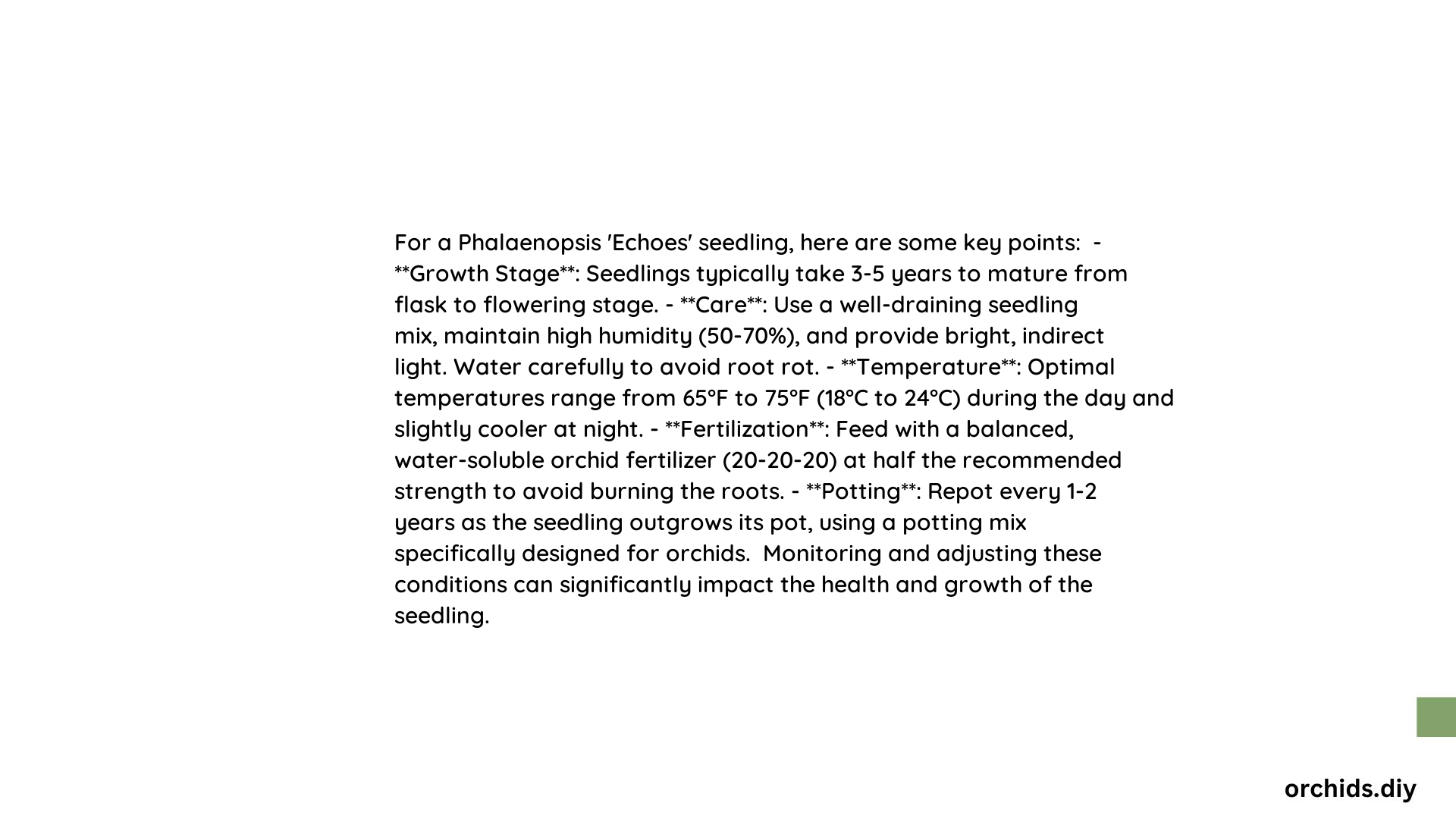Phalaenopsis Echoes seedlings are a captivating variety of moth orchids known for their unique coloration and patterns. These delicate seedlings require specific care to thrive and develop into stunning mature plants. Proper light, humidity, and nutrient management are crucial for their growth. This guide will explore the essential aspects of cultivating Phalaenopsis Echoes seedlings, from optimal growing conditions to common challenges and solutions.
What are the Ideal Light Conditions for Phalaenopsis Echoes Seedlings?
Phalaenopsis Echoes seedlings require carefully controlled light conditions to flourish:
- Intensity: Bright, indirect light is optimal
- Duration: 12-14 hours of light per day
- Spectrum: Full-spectrum light with emphasis on red and blue wavelengths
To achieve these conditions, consider the following:
- Place seedlings near an east-facing window
- Use sheer curtains to filter direct sunlight
- Supplement with grow lights if natural light is insufficient
| Light Parameter | Recommended Range |
|---|---|
| PAR | 20,000-40,000 lux |
| Kelvin | 5000-6500K |
| Daily Exposure | 12-14 hours |
How to Maintain Proper Humidity for Phalaenopsis Echoes Seedlings?

Humidity plays a crucial role in the health of Phalaenopsis Echoes seedlings:
- Ideal Range: 50-70% relative humidity
- Consistency: Maintain stable humidity levels throughout the day
Methods to increase humidity:
- Use a humidity tray filled with pebbles and water
- Group plants together to create a microclimate
- Employ a room humidifier for larger growing areas
Avoid misting the leaves directly, as this can lead to fungal issues.
What are the Nutrient Requirements for Phalaenopsis Echoes Seedlings?
Proper nutrition is essential for healthy growth:
- Fertilizer Type: Balanced, water-soluble orchid fertilizer
- N-P-K Ratio: 20-20-20 or similar balanced formula
- Application: Dilute to 1/4 strength for seedlings
- Frequency: Feed weekly during active growth, monthly during dormancy
Micronutrients are also crucial:
- Iron
- Magnesium
- Calcium
Ensure your fertilizer includes these trace elements or supplement as needed.
How to Control Root-Zone Temperature for Optimal Growth?
Root-zone temperature management is critical for Phalaenopsis Echoes seedlings:
- Daytime Range: 18-24°C (64-75°F)
- Nighttime Range: 16-21°C (60-70°F)
Strategies for temperature control:
- Use a thermometer to monitor root-zone temperature
- Adjust ambient room temperature as needed
- Consider a heat mat for cooler environments
Avoid extreme temperature fluctuations, which can stress the seedlings.
What are the Best Potting Techniques for Phalaenopsis Echoes Seedlings?
Proper potting is crucial for seedling development:
- Substrate: Well-draining orchid mix
- Pot Size: Slightly larger than the root ball
- Drainage: Ensure adequate holes in the pot
Recommended potting mix composition:
- 50% fine-grade orchid bark
- 25% perlite
- 25% sphagnum moss
Repot seedlings annually or when they outgrow their current container.
How Often Should Phalaenopsis Echoes Seedlings be Watered?
Watering frequency depends on several factors:
- Potting medium
- Ambient humidity
- Temperature
- Air circulation
General watering guidelines:
- Allow the top inch of the potting medium to dry between waterings
- Water thoroughly, allowing excess to drain
- Adjust frequency based on environmental conditions
| Season | Watering Frequency |
|---|---|
| Spring | Every 5-7 days |
| Summer | Every 3-5 days |
| Fall | Every 7-10 days |
| Winter | Every 10-14 days |
What are the Most Effective Propagation Methods for Phalaenopsis Echoes?
Propagation of Phalaenopsis Echoes can be achieved through:
- Keiki Development:
- Wait for keikis to develop 2-3 leaves and roots
-
Carefully remove and pot in orchid mix
-
Division:
- Separate mature plants with multiple growth points
-
Ensure each division has adequate roots and leaves
-
Tissue Culture (Advanced):
- Requires sterile lab conditions
- Produces genetically identical clones
How to Identify and Treat Common Pests in Phalaenopsis Echoes Seedlings?
Common pests affecting Phalaenopsis Echoes seedlings include:
- Mealybugs:
- Appearance: White, cottony masses
-
Treatment: Isopropyl alcohol swab, neem oil spray
-
Spider Mites:
- Appearance: Tiny red or brown specks, fine webbing
-
Treatment: Increase humidity, apply insecticidal soap
-
Aphids:
- Appearance: Small, green or black insects
- Treatment: Rinse with water, apply neem oil
Preventive measures:
- Regular inspection of plants
- Maintain good air circulation
- Quarantine new plants before introducing to collection
By following these guidelines, you can successfully cultivate healthy and vibrant Phalaenopsis Echoes seedlings, ensuring their development into stunning mature orchids.
References:
1. https://www.youtube.com/watch?v=s4G8mawk1LA
2. https://www.reddit.com/r/orchids/comments/16fbgvs/a_small_beginner_guide_to_phalaenopsis_aka_moth/
3. https://www.reddit.com/r/houseplants/comments/qty5rp/phalaenopsis_orchid_plant_care_easy_or_difficult/
